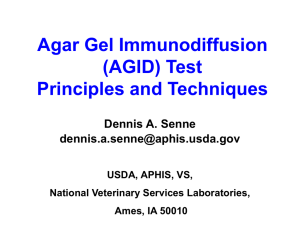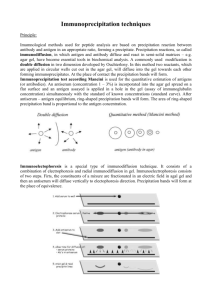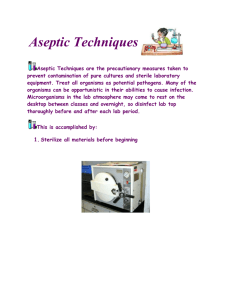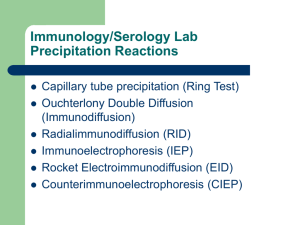Gel Immunodiffision
advertisement
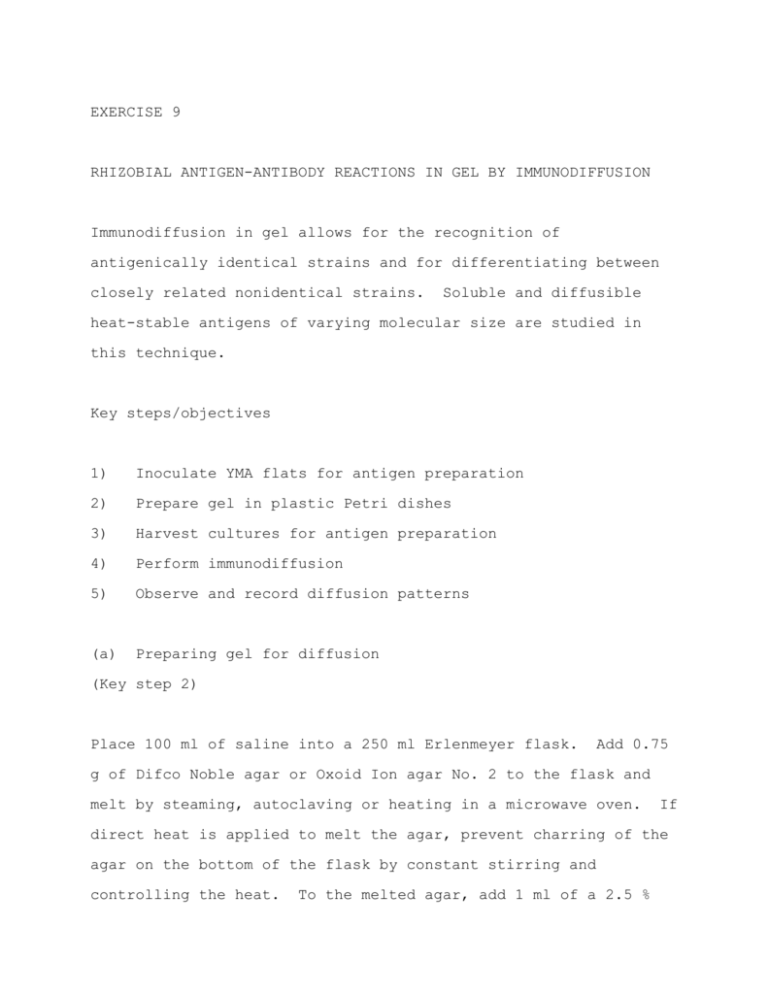
EXERCISE 9 RHIZOBIAL ANTIGEN-ANTIBODY REACTIONS IN GEL BY IMMUNODIFFUSION Immunodiffusion in gel allows for the recognition of antigenically identical strains and for differentiating between closely related nonidentical strains. Soluble and diffusible heat-stable antigens of varying molecular size are studied in this technique. Key steps/objectives 1) Inoculate YMA flats for antigen preparation 2) Prepare gel in plastic Petri dishes 3) Harvest cultures for antigen preparation 4) Perform immunodiffusion 5) Observe and record diffusion patterns (a) Preparing gel for diffusion (Key step 2) Place 100 ml of saline into a 250 ml Erlenmeyer flask. Add 0.75 g of Difco Noble agar or Oxoid Ion agar No. 2 to the flask and melt by steaming, autoclaving or heating in a microwave oven. If direct heat is applied to melt the agar, prevent charring of the agar on the bottom of the flask by constant stirring and controlling the heat. To the melted agar, add 1 ml of a 2.5 % (w/v) solution of sodium azide (a preservative), and swirl the flask to ensure proper distribution of the sodium azide. Pipette 25 ml of the hot gel into Petri dishes kept on a level surface. Allow the agar to solidify. A total of four plates with a gel layer 4 mm in thickness should result. Trace the outline of the bottom of a Petri dish on a sheet of white paper. Draw a hexagonal pattern of six circles (4 mm diameters) equidistant (5 mm from edge to edge) from one another in the center of the plate outline on this paper. Draw a seventh well in the center of the hexagonal pattern and shade in the circles (Figure 9.1). This pattern on the paper serves as a template for cutting out wells from the gel. Place a Petri dish (containing gel) on the template. of circles should be visible through the gel. gel using a 4 mm cork-borer. The pattern Cut wells into the The cork-borer should be held vertically when cutting the wells, otherwise wells with oblique walls will result. Carefully remove the gel plugs with pins or other suitable implement or remove the plugs by suction using a Pasteur pipette (with a slightly bent tip) attached to a suction apparatus. (A Pasteur pipette attached to an aspirator or vacuum pump, with a "trap" in between for the gel plugs, is a suitable suction apparatus.) It will take some practice to produce plates with seven intact wells. A drop of molten agar may be necessary to seal off the Figure 9.1. Hexagonal pattern template for Petri dishes. bottom of the well. Sealing the well is usually not necessary with the plastic Petri dishes but is essential for glass Petri dishes. The gel plates may be refrigerated if not required for immediate use. Make four sets (one set per Petri dish) of the hexagonal pattern of wells. Three or seven sets of wells can be made per Petri dish with sufficient experience and care. (b) Preparing antigens (Key steps 1 and 3) Culture the following strains of Bradyrhizobium sp. on YMA flats: TAL 651 (from Calopogonium mucunoides) TAL 653, 655, and 855 (from Centrosema pubescens) TAL 642 (from Lablab purpureus) Harvest the cultures after 7 days of growth (Exercise 6) and prepare antigen suspensions for immunodiffusion. A final volume of 1.0-1.5 ml of a dense antigen suspension containing approximately 1 x 1010 cells ml-1 is desirable. Divide the antigen suspension of each strain into two small screw-capped tubes. Small McCartney bottles are better substitutes if these are available. Heat treat one sample for 1 h at 100C by immersing the tube in boiling water. Leave the other sample unheated (untreated). (c) Setting up immunodiffusion reactions (Key steps 4 and 5) Place 2 drops (0.04 ml drop-1) of each heat-treated antigen in their respective wells. The position of the different antigens for the diffusion is as shown in Figure 9.2. Figure 9.2. Well pattern for immunodiffusion. Place the undiluted antiserum of TAL 655 in Well-7. Similarly, set up another set of wells for immunodiffusion with untreated (unheated) antigen. Labelling on the bottom of the Petri dishes is essential to facilitate the identification of the antigens in the wells. Orientation of the dish can be established with a single line at the 12 o'clock position and a diagrammatic record of the location of each well. Incubate the Petri dishes at room temperature in a water-saturated atmosphere. A saturated atmosphere is necessary to prevent moisture loss from the gel. Air-tight plastic boxes can be improvised to provide this environment by placement of wet paper towels on the inside prior to closing of the boxes. Make observations at 24 and 48 h. the form of drawings. Record your observations in Compare the diffusion patterns of the heated and unheated antigens. Interpret the diffusion patterns for reactions of identity, partial identity, and nonidentity. Heating can significantly alter the reactivity, concentration and diffusibility of the somatic antigens leading to stronger and well separated precipitin bands. Figure 9.3. Immunodiffusion reactions showing preciption bands. Requirements (a) Preparing gel for diffusion Autoclave, stove or microwave oven Saline (100 ml) Erlenmeyer flask (250 ml) Sodium azide Noble agar (purified agar) from Difco, Detroit, Michigan or Oxoid Ion agar No. 2 Plastic Petri dishes (four) Hexagonal pattern template Cork-borer (4 mm) (b) Preparing antigens Agar slant cultures of bradyrhizobia (TAL 642, 651, 653, 655, and 855) or other rhizobia YMA slopes (five) in 500 ml flat medicine bottles Screw-capped tubes (or small McCartneys) Steam- or water-bath (c) Setting up immunodiffusion reaction Pasteur pipettes Rubber bulbs (1-2 ml capacity) Air tight plastic boxes (or substitute of similar function)
